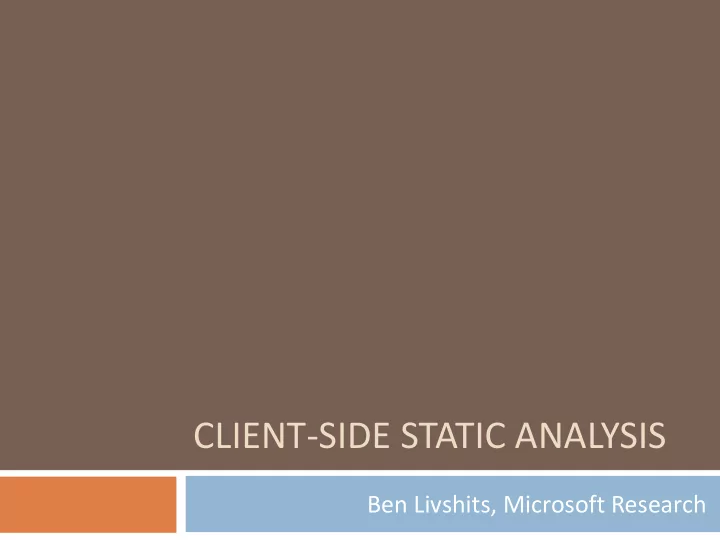

CLIENT-SIDE STATIC ANALYSIS Ben Livshits, Microsoft Research
Overview of Today’s Lecture 2 Client-side JavaScript Browser Analysis of JavaScript Plugins eval and code Extensions obfuscation Firefox extension model Need for runtime Chrome extension enforcement model Looking forward Gatekeeper as illustration
Layers of Browser Security 3 JavaScript JavaScript Extension plugin plugin plugin browser OS
App Store: Centralized Software Distribution 4 developer app store Code submission Do checking/verification as part of app approval process
Static Analysis 5 Last time Today Server-side analysis Client-side analysis Benign but buggy Buggy or potentially code malicious code Analysis soundness really helps
Same Origin Policy Is Not Enough 6 Primary focus: statically enforcing security and reliability policies for JavaScript code These policies include semantic properties restricting widget capabilities, making sure built- in objects are not modified, preventing code injection attempts, redirect and cross-site scripting detection, preventing global namespace pollution, taint checking, etc. Soundly enforcing security policies is hard
Gatekeeper Mostly Static Enforcement of Security & Reliability Policies for JavaScript Code 7
alert(„hi‟); program malicious Catch me if you can don’t want to allow alert box ? can we figure this out statically? 8
alert („hi‟); document.write( “<script>alert(„hi‟);</script>”); var d = document; var w = d.write; w(“<script>alert(„hi‟);”); 9
eval (“do”+”cu”+” ment.write (”+… var e = window.eval; e(“do”+”cu”+” ment.write (”…”); 10
var e = new Function (“ eval ”); e.call( “do”+”cu”+” ment.write (”…”); var e = new Function(unescape (“%65%76%61%6C”)); e.call (“do”+”cu”+” ment.write (”…”); 11
Gatekeeper Static analysis for JavaScript • General technology we developed for JavaScript • Can use for performance optimizations, etc. This paper • Use to enforce security and reliability policies • Analyze Web widgets Focus on whole program analysis. Contrast with: • JavaScript language subsets (do a little of) • JavaScript code rewriting (do a little of) 12
Goal of Gatekeeper: Reason about JavaScript code alert(„hi‟); statically Gatekeeper 13
JavaScript Widgets // register your Gadget's namespace registerNamespace("GadgetGamez"); // define the constructor for your Gadget (this must match the name in the manifest xml) GadgetGamez.gg2manybugs = function(p_elSource, p_args, p_namespace) { // always call initializeBase before anything else! GadgetGamez.gg2manybugs.initializeBase(this, arguments); // setup private member variables var m_this = this; var m_el = p_elSource; var m_module = p_args.module; /**************************************** ** initialize Method ****************************************/ // initialize is always called immediately after your object is instantiated this.initialize = function(p_objScope) { // always call the base object's initialize first! GadgetGamez.gg2manybugs.getBaseMethod(this, "initialize", "Web.Bindings.Base").call(this, p_objScope); var url = "http://www.gadgetgamez.com/live/2manybugs.htm" m_iframe = document.createElement("iframe"); m_iframe.scrolling = "yes"; m_iframe.frameBorder = "0"; m_iframe.src = url; m_iframe.width="95%"; m_iframe.height="250px"; p_elSource.appendChild(m_iframe); }; GadgetGamez.gg2manybugs.registerBaseMethod(this, "initialize"); /**************************************** ** dispose Method ****************************************/ this.dispose = function(p_blnUnload) { //TODO: add your dispose code here 14 // null out all member variables m_this = null;
Sample iGoogle Gadget 15
Widget counts 5,000 4,500 4,000 3,500 3,000 Widgets are 2,500 2,000 everywhere… 1,500 1,000 500 0 Live.com Vista sidebar Google/IG Lines of code 300 We use over 8,500 250 200 widgets to evaluate 150 Gatekeeper 100 50 0 Live.com Vista sidebar Google/IG 16
Gatekeeper: Deployment Step on Widget Host user developer Hosting site: control widgets Widget: by enforcing policies: … alert(‘hi’); - No alert … - No redirects - No document.write 17
Outline • Statically analyzable subset JavaScript SAFE • Points-to analysis for JavaScript • Formulate nine security & reliability policies • Experiments 18
T ECHNIQUES 19
Start with Entire JavaScript… EcmaScript-262 var e = new Function(“ eval ”); e.call( “do”+”cu”+” ment.write (”…”); var e = new Function(unescape (“%65%76%61%6C”)); e.call (“do”+”cu”+” ment.write (”…”); 20
Remove eval & Friends… EcmaScript 262 - eval - setTimeout - setInterval - Function - with - arguments array ----------------------- = JavaScript GK 21
Remove Unresolved Array Accesses… EcmaScript 262 JavaScript GK - innerHTML assignments - non-const array access a[x+y] -------------------------------- = JavaScript SAFE var z = ‘ ev ’ + x + ‘al’; var e = document[z]; eval is back! 22
Now, this is Amenable to Analysis! EcmaScript 262 JavaScript GK – need basic instrumentation to prevent runtime code introduction JavaScript GK JavaScript SAFE s ::= // assignments v1=v2 v = bot return v // calls JavaScript SAFE – can analyze v = new v0(v1,…, vn) v=v0(vthis,v1,…, vn) fully statically without // heap resorting to runtime checks v1=v2.f v1.f=v2 // declarations v=function(v1,…, vn){s} 23
How Many Widgets are in the Subsets? JavaScript SAFE Gatekeeper Safe JavaScript GK 97% 100% 90% 82% 80% 70% Ultimately, can analyze 65% 65% 60% 65-97% of all widgets 50% 39% 40% 30% 23% 20% 10% 0% Live.com Vista sidebar Google/IG 24
Sound analysis: JavaScript SAFE Sound ensures that our Input Sound with JavaScript GK instrumentation program policy checkers find all violations Everything No guarantees else 25
Points-to Analysis in Gatekeeper Points-to analysis • Program – Inclusion-based representation – Field-sensitive – Build call graph on the fly • Tricky issues: – Prototypes – Function closures • Analysis is expressed in Datalog PointsT o(var, heap) 26
Datalog Policy for Preventing document.write 1. DocumentWrite(i) :- 2. PointsTo("global", h1), 3. HeapPointsTo(h1, "document", h2), 4. HeapPointsTo(h2, "write", h3), 5. Calls(i, h3). document.write('<Td><Input Type="Button" document.write ("<" + "script Name="' + i + '" Value=" " Class="blokje" document.write('<iframe id="dynstuff" src="" language='javascript' type='text/javascript' onClick="wijzig(this.form,this)"></Td>'); '+iframeprops+'></iframe>') src='"); 27
E XPERIMENTAL E VALUATION 28
Recommend
More recommend